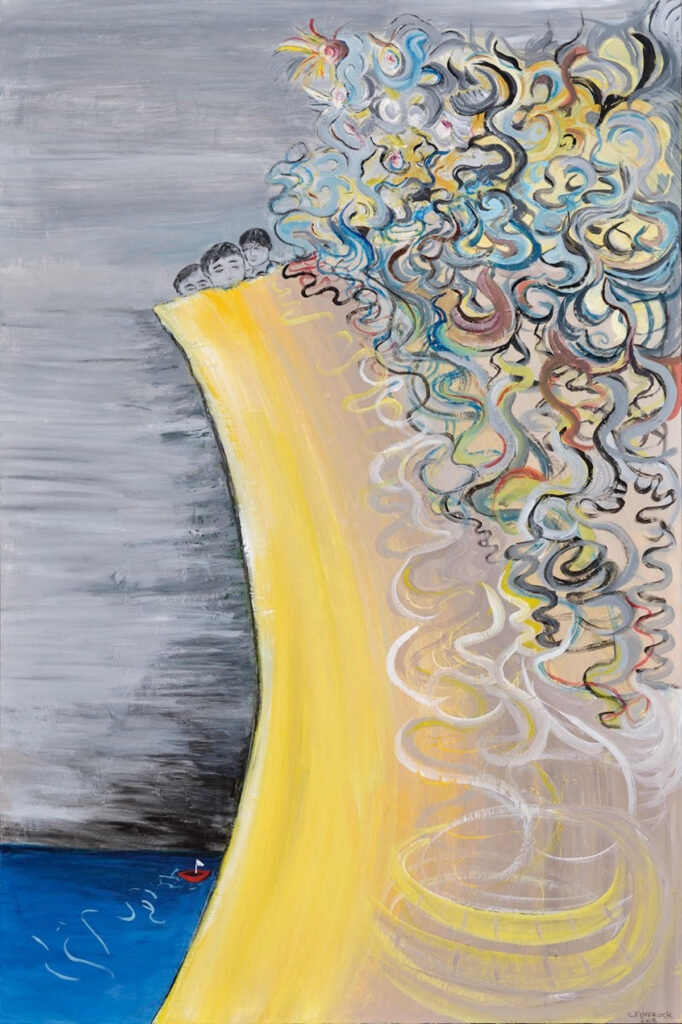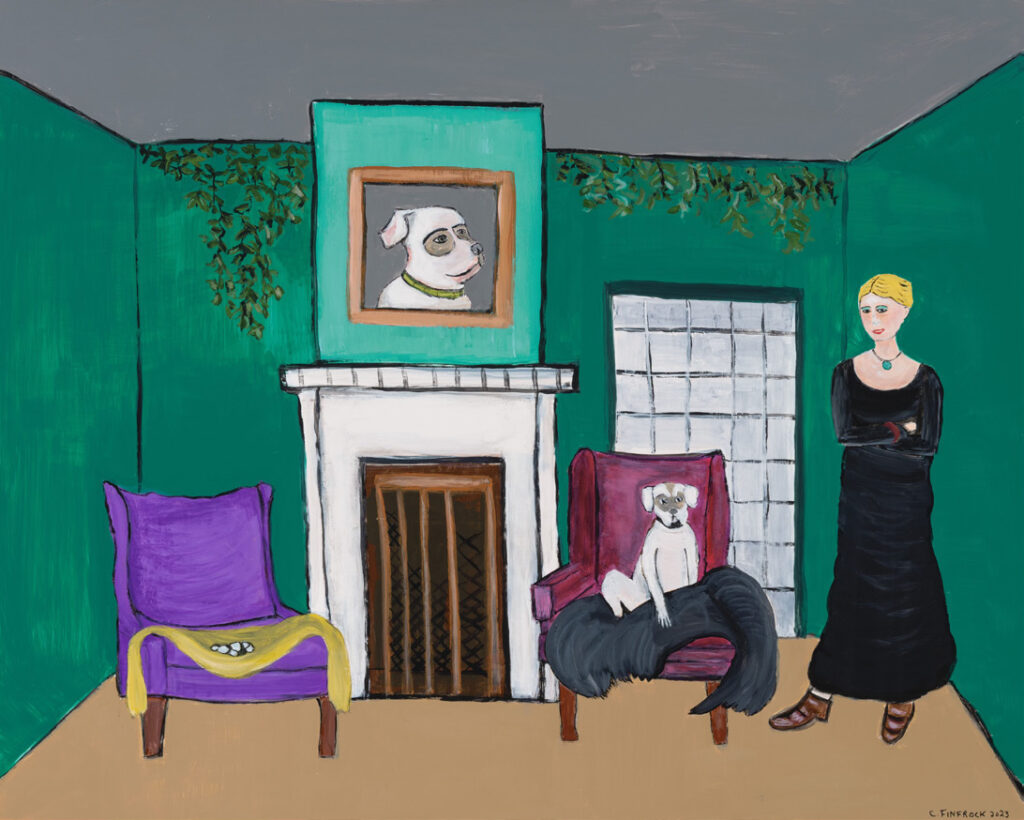
Sometimes the most meaningful thoughts are conveyed simply. The abstraction or gesture of reality in artwork conveys more to the viewer than detailed, fact-filled renderings by its creator so that the observed work is intuitively and intimately understood. Paintings perceived as naïve, results of simple surface depictions, stem from the artist’s heart as releases of underlying human emotional complexities, while freeing the viewer’s mind to experience newly engendered ideas.
In a recent solo exhibit, “The Ties That Bind,” Cheryl Finfrock’s works are about the concept of the Fates, or Moirai in Greek mythology, in which three sisters are the Goddesses of fate. The tradition of Texas storytelling also plays a part, as subtle thoughts about survival in vast sparse geographical landscapes subliminally influence her examination of Fate. Produced over two years, the pieces concern connections, especially human ones, that contribute to the artist’s virtual stage settings of pictorial narratives, where she strips psychological intricacies to their essences as disguised commentary on “selective attention.” The subjects are emotionally detached renderings belying anxious feelings beneath surfaces and underscoring awareness of modern isolated living compared with communal human existence shared by humankind for eons.
A strong sense of life’s difficulties can be felt in many of the works as the subjects’ faces seem deceptively simple, as they reside in banal environments, but we see their haunted eyes staring out at us with discontent. Upon viewing the paintings, we mentally flesh out the naïve renderings to draw deeper conclusions to unsaid back stories as the artist creates space in the realm of thought to elicit from us a range of personal responses.
In the painting Gravity’s Exquisite Pull, three small human heads peek out from the painting’s upper part, as tsunami-like waves of string threaten impending doom. To me, the images refer to the Fates and perhaps are emblems of the three Sisters assigning our destinies. The trio perches near a precipice reminding me of the myth of Sisyphus, about a straining figure repeatedly pushing a rock up a mountain for eternity to no avail. I think of Camus asking us to assign personal meanings to our fates to keep us from despairing about our finality, knowing death and gravity indubitably triumph in the end.

“The subjects’ faces seem deceptively simple, as they reside in banal environments, but we see their haunted eyes staring out at us with discontent.”
Finfrock’s pieces are produced primarily on clayboard where outcomes are likened to illuminated flickers of light on a darker background, detailed images arising from the pictorial surface. She is helped to realize her creations by photos as the picture plane serves as stage for the subjects’ performances in lighted scenes. Her placement of lone people in minimally furnished rooms “provides the viewer pause” that Finfrock likens to “a moment of thought before action is taken.”
In Finfrock’s painting, His Words Fell Off the Paper; The Coffee Ground Them Clean, the artist shows us a subject, perhaps a writer, closed off from emotional connections, hugging himself to shield his body from any human intrusions. His anxious mien is almost androgynous. We don’t know who he is, but he could
be everyman. The luminous blue of his shirt draws our eyes up to the subject’s uneasy gaze in this incomplete story. As he stands before a wall highlighted by textured Xs, we ask, are these cross-hatchings signs of suffering? To whom does the garment hung on the wall belong? Was it an emblem of detritus from the past? The smiling pit bull beneath the table is a gentle foil to the implicit tensions from the picture’s questions, bringing a touch of happiness to a scene filled with dread.
The painter has a deep connection with animals and she homages them in her piece, Almost a Seat for All, where she enshrines her pit bull above the mantle. Frequently depicting them in her artwork, Finfrock views her dogs as “pure, old souls, always with us” after their days end, giving them a “visible footprint to that which is invisible,” a sanctification in sparse scenes. Like the man in the previously mentioned piece, the woman in this painting, too, is isolated, closely holding herself in a long, dark, dress, reminding me of a gothic heroine. Again, we see Finfrock’s ability to depict psychological dimensions, her astute skills of observation affording us “a deeper look at those who are passed by.”
Finfrock’s use of simplification of subject, employing figures in stances of pregnant pause, impels me to repeatedly ask why this manner of interpretation? Her childlike renderings are deceptive snapshots, stilled life vignettes, hints for real lives lived, with all their serious intricacies. Is this where our wisdom lies today? Is it lost in a sea of knowledge drowning in unending information waves? Do we know where to look? Cheryl Finfrock responds to our queries by creating images as buoys to guide us when diving for answers; the gold we hope to find is concealed, until we open her treasure chest so we may discover the simple gifts. G&S





Leave a Comment